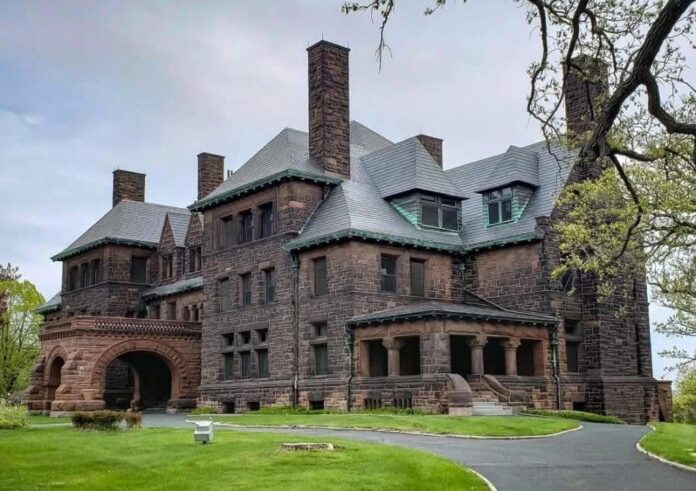James J. Hill House, Saint Paul, Minnesota
A Gilded-Age Masterpiece on Summit Avenue
1. Overview
Rising above the bluffs that overlook downtown Saint Paul and the Mississippi River, the James J. Hill House is one of the largest—and best-preserved—Gilded-Age residences in the Midwest. Completed in 1891 for railroad tycoon James J. Hill, the 36,000-square-foot mansion quickly earned the nickname “the showcase of St. Paul.” Today it is both a U.S. National Historic Landmark and a cornerstone of the city’s Historic Hill District, interpreted and cared for by the Minnesota Historical Society.
2. Prime Location on Summit Avenue
Hill secured three prominent lots at the eastern end of Summit Avenue in 1882, joining a wave of wealthy St. Paulites eager to claim the avenue’s commanding views of the city and the river valley. The family’s earlier Lowertown home had become hemmed in by warehouses and rail lines—hardly fitting for a man hailed as the “Empire Builder.” Summit Avenue offered space for an expansive residence and room to display Hill’s growing fine-art collection.
3. Design & Construction (1887 – 1891)
| Key Facts | Details |
|---|---|
| Architects (initial) | Peabody, Stearns & Furber (Boston) |
| Architects (final) | Irving & Casson (Boston) |
| Architectural style | Richardsonian Romanesque |
| Exterior materials | Heather-colored granite, red sandstone trim |
| Total space | 44,552 sq ft (4,139 m²) |
Hill personally oversaw nearly every detail of construction. He chose an East-Coast firm to set his mansion apart from neighboring homes by local architects such as Cass Gilbert. When plans or materials failed to meet his rigorous standards—Tiffany’s stained-glass concept, for example—Hill simply replaced vendors and even dismissed the original architects midway through the build.
4. Richardsonian Romanesque Grandeur
- Mass & Scale: Random-course granite blocks, squat turrets, and deep-set arched windows lend the mansion the weighty, fortress-like presence characteristic of H. H. Richardson’s late-Victorian style.
- Horizontal Emphasis: Broad rooflines and belt courses visually anchor the house to its bluff-top site.
- Asymmetry: A complex roofscape, recessed loggias, and a sweeping carriage porch create a dynamic silhouette.
5. Cutting-Edge Technology
Hill insisted on incorporating the latest household innovations:
- Hybrid Gas-and-Electric Lighting – rotary switches controlled early Edison bulbs, while gas fixtures provided backup.
- Advanced Plumbing & Ventilation – separate hot- and cold-water systems, flush toilets, and a modern furnace ensured comfort.
- Fireproofing – brick firewalls, steel I-beams, and fire-resistant doors reflected Hill’s obsession with safety long before building codes demanded it.
6. Interior Highlights
| Floor | Principal Rooms | Notable Features |
|---|---|---|
| First | Art gallery, music room, library, drawing room, formal dining room, Hill’s office | Hand-carved oak and mahogany, gold-leaf ceiling panels, a custom 1,006-pipe organ |
| Second | Hill and Mary Hill’s suites, two guest rooms, five daughters’ bedrooms | Private sitting rooms, built-in wardrobes, marble-and-tile baths |
| Third | Bedrooms for sons James, Walter, and Louis; schoolroom/gymnasium; servants’ quarters | Barrel-vaulted ceilings, skylit corridors |
| Basement & Attic | Kitchens, laundry, wine cellar, cold-storage rooms; storage lofts | Oversized masonry arches, freight elevator |
The Art Gallery—lit by a massive skylight—once displayed masterpieces by Corot, Bouguereau, and other European painters. Many original works now reside at the Minneapolis Institute of Art, but rotating exhibits still animate the space.
7. Life Inside a 19th-Century “Family Home”
Despite its size—32 fireplaces, 22 fireplaces, 13 bathrooms, and countless servants—the house was never intended as a flashy palace. Contemporary newspaper accounts praised its “solid, substantial, roomy, and comfortable” atmosphere. Hill hosted business meetings, charity balls, and intimate family gatherings here until his death in 1916. His wife Mary remained until 1921, after which the children donated the property to the Roman Catholic Archdiocese. The church operated offices and classrooms until 1978, when the Minnesota Historical Society acquired and painstakingly restored the mansion.
8. Preservation & Landmark Status
- 1975: Designated a National Historic Landmark for its architectural integrity and association with James J. Hill.
- 1978 – 1991: Comprehensive restoration—structural stabilization, conservation of woodwork, replication of wall coverings, and re-creation of period lighting—returns the interiors to their 1891 appearance.
- Today: The house anchors the 1.7-square-mile Historic Hill District, recognized nationally for its rich collection of Victorian architecture.
9. Visiting the James J. Hill House
- Tours: Guided tours explore four floors, the art gallery, and the expansive back-of-house service areas.
- Special Programs: Organ recitals, Victorian holiday events, and architectural photography sessions.
- Accessibility: Elevator service to the main and second floors; ramps at the carriage porch entrance.
- Location: 240 Summit Avenue, Saint Paul, just west of the Cathedral of Saint Paul.
For current hours, tickets, and program schedules, consult the Minnesota Historical Society’s official website or call the site box office.
10. Why It Matters
The James J. Hill House is more than a monument to one man’s wealth; it embodies a transitional moment in American domestic architecture:
- Technological Leap: Electricity, indoor plumbing, and fireproof construction foreshadowed 20th-century conveniences.
- Cultural Ambition: Hill’s art gallery signaled the Midwest’s emergence as a player on the national cultural scene.
- Urban Evolution: Summit Avenue’s rise as an elite enclave underscores St. Paul’s transformation from frontier town to industrial capital.
Whether you’re an architecture buff, a railroad enthusiast, or simply curious about life at the turn of the 20th century, a visit to the Hill House offers a richly immersive journey into Minnesota’s past.

